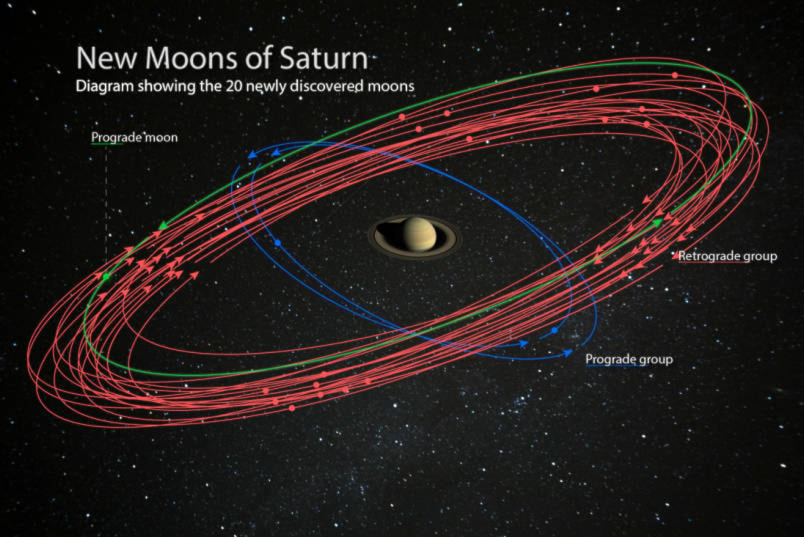Researchers using the Subaru Telescope in Hawaii have found 20 more moons orbiting Saturn. This brings the total orbiting the planet to 82, overtaking Jupiter, for which the total discovered so far is 79. These new satellites are all about five kilometres in diameter, and discovering them is an indicator of the quality of modern telescopes.
Our Earth has one, quite a large moon. Mercury and Venus have none, and Mars has two. However the giant planets, Jupiter, Saturn, Uranus and Neptune have large collections of moons, and as our instruments improve and our spacecraft pass by, we are finding more. Is this due to the planets acquiring new moons, or is this simply due to improvements in our instruments?
Thanks to our having several telescopes watching for them, almost every year we notice an asteroid passing us close by, sometimes closer to us than the moon. Even when this happens, and the Earth’s gravitational attraction on that asteroid is stronger than the Earth’s pull on the moon, the asteroid does not get captured; it passes by and continues on its orbit around the Sun. The reason is simple. As the asteroid approaches the Earth, it accelerates due to the Earth’s pull. When it swings past the Earth, it will be going fast enough to escape into space with the speed it had before it encountered us, although it will probably be moving in a different direction. To be captured it needs something to slow it down a bit. The empty vacuum of space has nothing in it to do that, which is why our Earth is circled only by the moon, satellites we have launched and a growing accumulation of space junk. There might be a tiny extra moon out there that we haven’t found yet. The same applies to the giant planets, Jupiter, Saturn, Uranus and Neptune. Anything orbiting the sun that flies past them will head back off into space. However, it has not always been like that.
The solar system formed from the collapse of a big cloud of gas and dust. It collapsed into a rotating disc, with the centre becoming the sun. In the remaining disc material smaller discs formed, which collapsed to form the planets and their moons. These moons orbit in the same direction as the planets’ rotation. For example, our Earth rotates eastwards, and that is the direction of the moon’s orbital motion. While any remaining disc material is present, an object orbiting the sun and coming too close may be slowed down enough by that material to be captured, becoming a new moon. This is most likely for the giant planets because they formed from large discs, which provide particularly large “catcher’s mitts.” These outside additions can end up in any sort of orbit and can even move in the opposite direction to the other moons. Seventeen of Saturn’s moons have these reverse or retrograde orbits, suggesting they are external additions.
In the outer solar system, around the giant planets there are opportunities for passing objects to seem to be captured but actually, aren’t. If the encounter is at the right speed and the right distance from the planet, an object might make an almost complete orbit before wandering back off into space. This apparent orbit might be many years long, so it will take time and some careful measurements to find out whether an object is a distant moon or a visitor. The data for these new Saturnian moons were collected between 2004 and 2007, which produced enough information for some new computing algorithms to derive orbits for the discoveries. Over the coming years, as our telescopes and calculations improve, we expect we will be finding even smaller moons, maybe as small as one-kilometre, and the count will go up.
Mercury and Venus might be visible very low in the southwest after sunset if the sky is clear. Jupiter and Saturn lie low in the southwest after dark. The moon reaches last quarter on Oct. 21.
Ken Tapping is an astronomer with the Dominion Radio Astrophysical Observatory. E-mail: ken.tapping@nrc-cnrc.gc.ca
